

However, if this dissipative heating is solely restricted to the shell, the local rate of heating may vary significantly due to crustal compositional heterogeneities and it is shown that this process may, in turn, produce thermal maxima in the crust, which could lead to local melting and structural instabilities, perhaps associated with the formation of chaos regions. Conversely, when considering the present thickness of Europa’s ice shell, if tidal heating is included at a global dissipation rate of ∼1 TW, the shell is found to be, on average, approximately 28 km thick. We find that in the absence of tidal heating and without the presence of low-eutectic impurities to serve as anti-freezes, a 100 km thick ocean solidifies in about 64 Myr. It is assumed that the shell is initially in a steady-state conductive regime, and the ocean is taken to be an infinite liquid half space cooling from above. This solution is then extended to estimate the present thickness of the ice shell. The time of crystallization of a 100 km thick ocean on Europa is estimated using a Stefan-style solidification solution. These results could yield significant implications for Europa's thermal history and evolution, habitability, and future spacecraft missions. Thus, subduction and ductile rolldown represent physically plausible mechanisms that could play a critical role in resurfacing Europa throughout its geologic history. Very thin conductive layer experiments, however, result in a previously undescribed process that we term ductile rolldown, which creates surface features similar to double ridges observed on Europa. Our results indicate that subduction could initiate over a broad range of surface thicknesses and deformation rates above a minimum conductive layer thickness, but is strongly dependent on the orientation of the pre-existing zones of weakness. By deforming the wax, strain on Europa's surface-possibly caused by diurnal tides or its nonsynchronous rotation-is simulated. Here, we aim to better understand the process and the conditions that could lead to initiation of subduction on Europa through physical experiments, using wax to simulate Europa's two-layered (i.e. However, basic physical parameters needed to initiate subduction on Europa, such as thickness of the brittle layer, deformation rates, and orientation of pre-existing zones of weakness at which subduction could start, are not well understood. Recently, evidence for potential plate tectonics, associated with subduction zones, has been discovered on Europa this could be responsible for recycling most of Europa's surface.

However, observed features related to shortening are scarce compared with pervasive extensive extensional features such as dilational bands, and do not suffice as the sole mechanism for recycling aging terranes. The surface of Europa indeed shows abundant evidence of tectonic deformation related to extension, strike-slip, and shortening.

Jupiter's Moon Europa has one of the youngest geological surfaces in our solar system with an age of 40–90 Ma, implying an intense history of resurfacing.


 0 kommentar(er)
0 kommentar(er)
